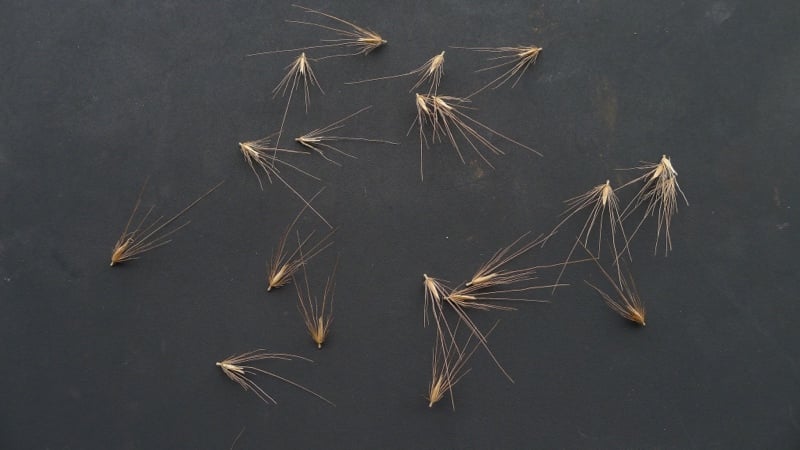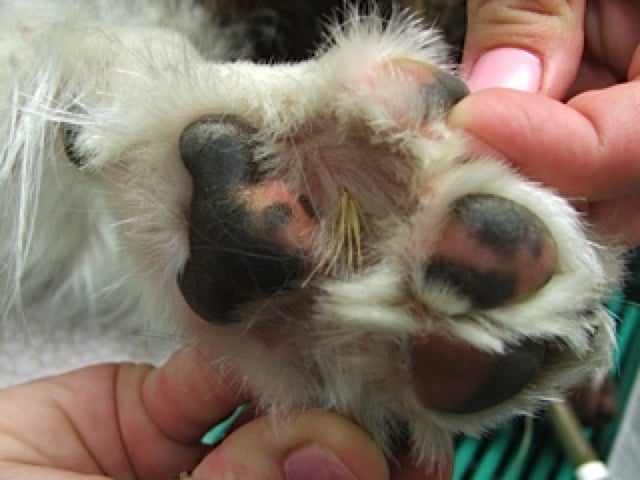Key Takeaways
- Foxtails can penetrate pets’ skin and be very painful.
- Foxtails are grass-like weeds that are prominent in the western U.S.
- The mature seeds of foxtails detach from the plant and look like fish hooks.
- Do not attempt to remove a foxtail yourself from a pet – schedule a vet appointment ASAP.
- Prevent foxtails by mowing your lawn and brushing your dog after walks.
Table of Contents

In spring, plants flower and produce seeds for growth. Some of these, like burrs and foxtails, can be extremely painful to dogs if they penetrate the skin. How can you protect your pet from these invasive pests? Read on to find out.
What is a foxtail?
Foxtails are grass-like weeds that bloom in spring, mostly in the western United States. They can grow from one to three feet tall, and get their name from the bushy seed pod on the top of the stalk. As the plant matures, the seeds detach and scatter.

How are they dangerous to dogs?
The mature seeds that detach from the plant are barbed like a fish hook. They are very sharp, and are easily picked up in the fur, ears, and paws of dogs. Because of their structure, they can work their way into the skin, causing infection and may even translocate to the organs.
How can I tell if my dog has a foxtail?
A dog that has a foxtail stuck will often attempt to remove it, depending on its location. If it’s in your dog’s nose, your pet will repeatedly sneeze or paw at the nose. If the foxtail is in the eye, excessive watering and swelling can occur.

Foxtails lodged in the skin or paw will sometimes form a painful, pus-filled lump called an abscess. This infection can be deadly to dogs, so seek immediate veterinary treatment!
What should I do to remove a foxtail?
Never attempt to remove a foxtail yourself – the barbs may break off inside the animal’s skin, which can lead to an abscess or migration to an internal organ.
Schedule an appointment with your veterinarian to remove the foxtail. If the seed has created a pus-filled abscess, your dog may require surgery for removal.
How are foxtails treated?
If you suspect your dog has a foxtail embedded in his or her skin, see your vet! Treatment of a foxtail depends on its location, but typically antibiotics are prescribed, either in cream or pill form.
Foxtails that have abscessed require surgical removal by your veterinarian. Surgery to remove a foxtail can run from $800 to $2,000 or more, depending on your pet’s size and condition.

Can I prevent foxtails?
Mowing your lawn regularly, especially in spring, can eliminate the seed pods from your yard. Brushing your dog after walks through grassy areas can also remove the foxtails from their coat, preventing them from puncturing the skin. Also, regularly inspect your dog’s eyes, ears, and paws for any abnormalities; these are all sensitive areas.
This spring and summer, keep your pet away from grassy areas frequented by the weed foxtail. If your animal does come into contact with it, make sure and brush its coat to remove all seeds. Regular inspection of your dog’s ears, eyes, and paws can also make sure no thorns have stuck in the skin, which can lead to a painful, pus-filled abscess.
The content is not intended to be a substitute for professional veterinarian advice, diagnosis, or treatment. Always seek the advice of your veterinarian or other qualified health provider with any questions you may have regarding a medical diagnosis, condition, or treatment options.







